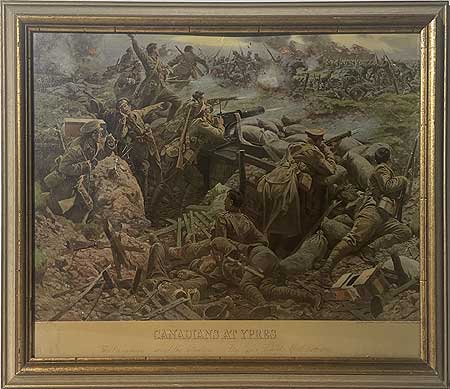 |
The second battle of Ypres, 22nd, April 25 of May 1915 the Canadian stand during the second battle is portrayed which retained control of the tactically important high ground to the east and south of the Flemish town of Ypres in western Belgium. The First Battle of Ypres had been fought the previous autumn. The Second Battle of Ypres was the first mass use by Germany of poison gas on the Western front.
The Germans prepared for a limited offensive in Belgium in spring 1915 against the Ypres salient, a bulge in the Allied lines. The last major Belgian town in Allied hands, Ypres provided a defensive position from which to protect French ports on the English Channel. It had to be held.
On 22 April, two Canadian brigades were in the front lines, with a third in reserve near Ypres. At 5 p.m., the Germans released gas against the French 45th (Algerian) Division to the Canadians’ left. An enormous green-yellow gas cloud, several kilometres long, drifted towards the French lines. When it rolled over their positions, French troops either suffocated or fled, their eyes and throats burning from the chlorine.
Most of the gas missed the Canadians, but the French retreat had exposed the Canadian’s left flank and threatened the destruction of the whole Allied position in the salient. General Alderson’s units shifted positions to cover the gap, but the German gas attack had torn a huge hole, several kilometres wide, in the Allied line.
From 22 April to 25 April, the Canadians fought tenaciously to defend this exposed position. Outnumbered, outgunned, and outflanked, on the 24th they faced a second, this time direct, chlorine gas attack. The Canadians counterattacked to stall the German advance, and then slowly gave ground, buying precious time for British troops to be rushed forward.
A New Reputation but High Casualties
The Canadian Division’s trial-by-fire at Ypres earned the Canadians a reputation as tough and dependable troops, but they had paid a high price: some 6,000 casualties over the four-day battle
The Germans moved field artillery forward, placing three army corps opposite the 27th and 28th Divisions on the Frezenberg ridge The German attack began on 8 May with a bombardment of the 83rd Brigade in trenches on the forward slope of the Bellewaerde ridge, but the first and second infantry assaults were repelled by the survivors. However, the third German assault of the morning pushed the defenders back. Although the neighbouring 80th Brigade repulsed the attack, the 84th Brigade was pushed back; this left a 2-mile (3.2 km) gap in the line. The Germans were prevented from advancing further by the PPCLI's counter-attacks and a night move by the 10th Brigade. The PPCLI held the line at a steep cost; their 700-man force was reduced to 150, who were in no shape to fight. After this, their unofficial motto—"Holding up the whole damn line"—is still used today. |
 |
 |


